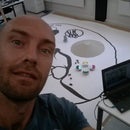Introduction: Laser Cut Wooden Lamp Shade
I wrote this instructable to help people build a lamp shade from scrap wood just like I did.
To realise this project you'll need a piece of MDF wood 3mm thick and 58x32mm wide. I gathered mine from the trash around my work as I am lucky to work in a university where architecture students throw a lot of this. You will also need a laser cutter that can cut such a piece of wood (I used a trotec speedy 400). Finally you'll need a E27 bulb holder such as this one.
If you want to improve the design or modify it to suit your taste you'll need to get confortable with tinkercad which should be very fun as it is free, online and very accessible. You will also need to rethink some simple mechanics which can be tricky but which you can take as a fun puzzle to play with.
Step 1: Optional: Prototype
If you simply want to build the lamp jump to step 3 !
If you want to make your own design or modify mine then follow along.
In that case the first step will be for you to explore what possible design you can do. If you are more creative than me then just take a pen and have fun on a piece of paper. If you don't feel inspired (I was not that much) then search on google image for some designs of lamp shades. Take a break, digest, create an account on tinkercad and try to make your own design.
The constraint I focused on was that I did not want to put any glue and so I needed all my junctions to be perpendicular to attach them using a simple notch as shown in the image above. Using this constraint, but without designing the notches yet, experiment and try to design different models. Above you can see three versions that led me to my final design. I also attached the final 3D model of my final design without the junctions above. Unfortunately I did not find a way to get a format where you can import the model and see it as I see it on tinkercad...
Attachments
Step 2: Optional: Final Design
Once you reach the design that suits your taste, you'll now need to spend a bit of time to design the junctions. In the case of my design, I used the fact that my model is the result of a revolution to simplify the work I had to do.
How did I do ? I only kept one side piece and designed the holes I needed on the bottom, top and side piece. I applied the holes to the side piece and put that piece aside. Then I duplicated the holes of the bottom and top piece following a central symmetry around the center axis of the model. then as I wanted 24 side pieces, I duplicated the two resulting holes and rotated each time 15 (360/24) degrees to complete a full turn. I then applied the holes to the bottom and top piece and got the final model with the notches.
But as you may know, a laser cutter is not a 3D printer, we can only give it a 2D file as an input. So how to get that from our 3D model ? Simple: lay all the pieces of your model flat on the work plane, select all the object, and click the export button. You can then get the svg file that you need to provide your laser cutter ! See the next step to get the resulting file.
Step 3: Laser Cut and Mount
Know you did the hard job (or you skipped it ;)), time to make the machine work for us. Send the attached file or your own file to the laser cutter and mount ! I hope that helped you decorate your house and have fun as much as I had.















